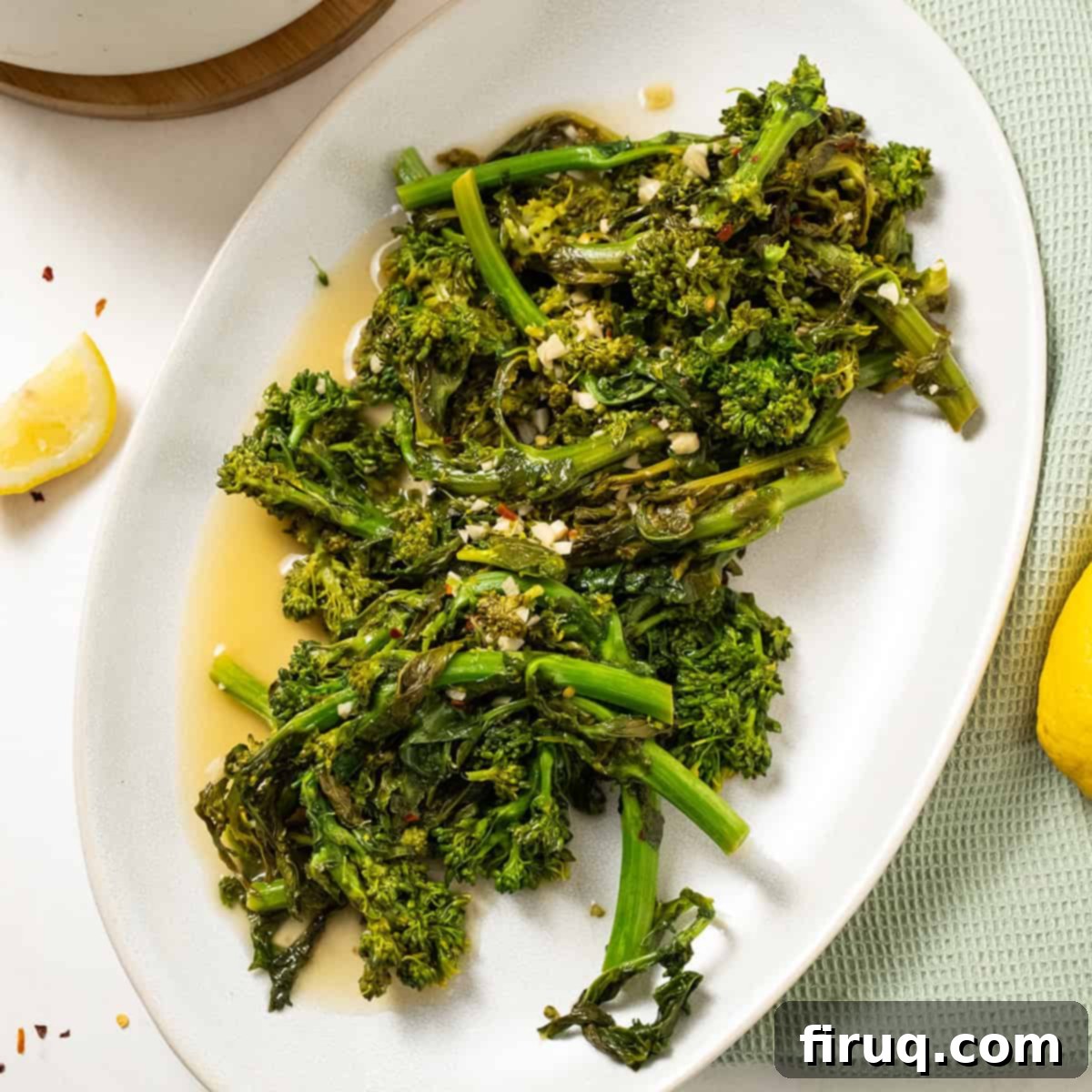Delicious Sauteed Rapini with Garlic: Your Go-To Broccoli Rabe Side Dish
This incredibly easy recipe will guide you through making a truly delicious plate of sauteed rapini with garlic, perfectly suited for a versatile side dish, a robust sandwich topping, or even a delightful cold snack. Rapini, also widely known as broccoli rabe, boasts a distinct and intensely unique flavor profile. If you haven’t had the pleasure of tasting this traditional Italian green, you’re undoubtedly missing out on a culinary experience that brings earthy notes, a pleasant bitterness, and a touch of authentic Mediterranean zest to any table.
Imagine serving this vibrant, garlicky green alongside your favorite main courses for a complete and satisfying meal. Its assertive yet balanced flavor makes it an excellent accompaniment to a variety of dishes. For instance, it pairs wonderfully with Pesto Stuffed Chicken, where its robust character can cut through the richness of the pesto, or with beloved Italian staples like Classic Italian Fried Meatballs, offering a fresh, slightly peppery counterpoint to the savory meat and rich tomato sauce. This simple preparation highlights the vegetable’s natural qualities, ensuring it becomes a cherished staple in your home cooking repertoire.
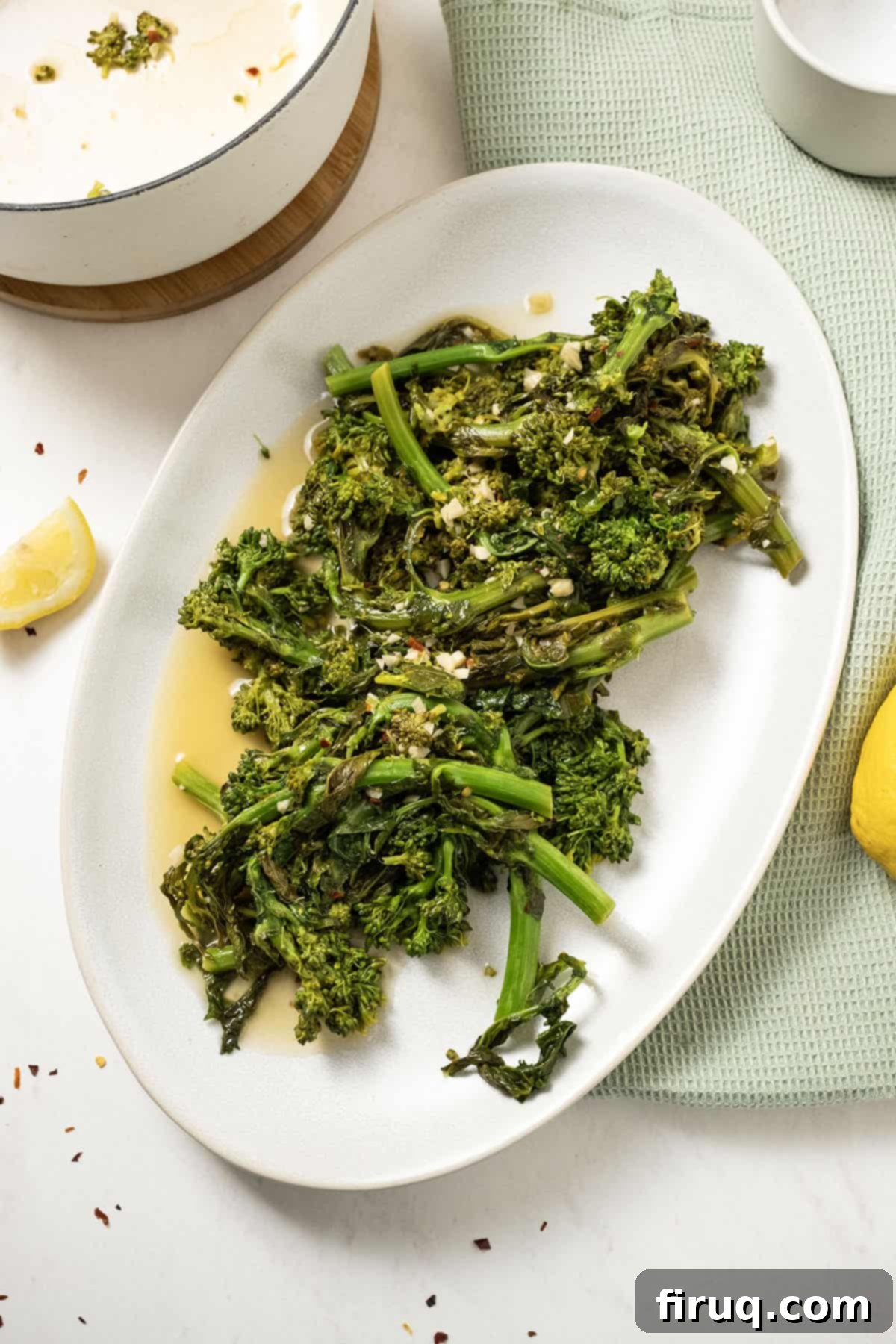
If you’re searching for more authentic Italian vegetable sides to complement your culinary creations, be sure to explore our delightful recipes for a crisp Italian Green Bean Salad or our timeless Traditional Caesar Salad.
[feast_advanced_jump_to]
Unveiling the Unique and Distinctive Flavor of Broccoli Rabe (Rapini)
For many, rapini, universally recognized and beloved as broccoli rabe, holds a special place in their heart and on their plate. Its bold, assertive, and undeniably unique flavor is precisely what makes it such a prized vegetable, especially in traditional Italian cuisine. I fondly recall my graduate school years, spending countless hours on the phone with my grandma, who patiently guided me through the intricacies of preparing this exceptional vegetable. Her lessons were particularly vital when it came to making her cherished Pasta with Sausage and Broccoli Rabe, a dish that perfectly exemplifies how rapini’s distinct taste can elevate a simple meal to something extraordinary.
If you’re new to the wonderful world of broccoli rabe, preparing it sautéed with garlic, as in this recipe, is the ideal introduction. Be prepared for a taste experience unlike any other leafy green. Its signature bitter flavor, far from being a flaw, is actually its most defining and celebrated characteristic. While people often tend to shy away from bitterness, our taste buds are equipped with receptors specifically designed to appreciate such complex nuances. When cooked properly – sautéed and steamed to perfection – rapini with garlic transforms into one of the most enjoyable and versatile vegetables you can eat. Its robust flavors hold up beautifully, making it equally delicious whether served hot, warm, or even cold.
The true key to appreciating and enjoying rapini lies in its preparation. It’s quite similar to eggplant in the sense that if it has the wrong texture, it can unfortunately ruin the entire dish. However, when expertly sautéed and steamed, achieving that perfect tender-crisp texture, it becomes utterly irresistible. Think of how crucial the precisely sliced and fried eggplant is in a classic Pasta alla Norma; rapini demands a similar attention to detail to unlock its full potential. The careful combination of high-quality olive oil, fragrant garlic, and a touch of heat mellows its inherent bitterness, transforming it into a savory, slightly peppery, and truly unforgettable side dish that captures the essence of Italian home cooking.
Essential Ingredient Notes for Perfectly Sauteed Rapini
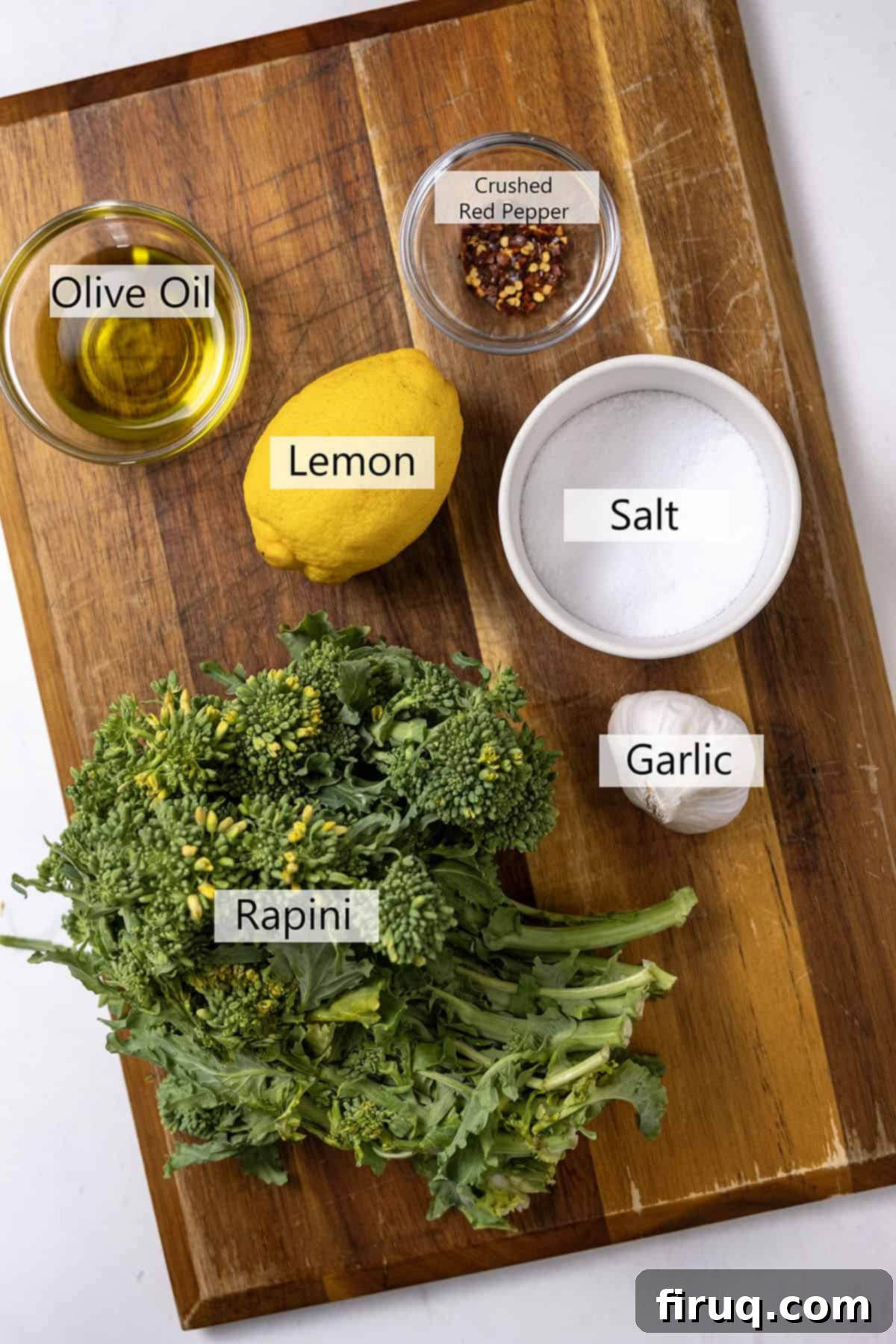
Achieving truly delicious sautéed rapini starts with selecting the best ingredients and understanding their crucial role in developing the dish’s flavor profile:
- Rapini (Broccoli Rabe): When selecting your rapini, always aim for a bushel with deep, vibrant green leaves and firm, tightly closed florets. The presence of any significant yellowing on the leaves or buds typically indicates that the vegetable is older or past its prime. While a little yellowing can sometimes be unavoidable, as you might observe in the image above, always strive for the freshest available. Before you begin cooking, it’s absolutely essential to thoroughly wash the rapini and trim off the tough, fibrous ends of the stalks, usually the bottom inch or two. This ensures a more tender and enjoyable bite, eliminating any chewy parts.
- Olive Oil: I cannot stress this enough in any of my blog posts, but choosing a quality extra virgin olive oil is paramount for recipes like this. In dishes where olive oil is a primary flavor carrier, its character will be present throughout every single bite. A high-quality oil will impart a rich, fruity, and sometimes peppery note that cheap, refined oils simply cannot replicate. Opt for the best you can afford; it truly makes a noticeable difference.
- Garlic: Fresh garlic is an absolute non-negotiable for this authentic Italian preparation. Minced garlic, gently sautéed until it becomes beautifully fragrant and just slightly golden, forms the aromatic backbone of this dish. It complements rapini’s inherent bitterness perfectly. Avoid pre-minced garlic from a jar; the fresh cloves offer unparalleled flavor and aroma.
- Crushed Red Pepper: This ingredient adds a delightful touch of heat and a subtle kick that awakens the palate and beautifully balances the earthy, slightly bitter flavors of the rapini. Adjust the amount to your personal preference – a little goes a long way, but a bit of warmth is essential for an authentic Italian-American experience.
- Lemon Juice: A generous squeeze of fresh lemon juice at the very end of the cooking process brightens the entire dish. The acidity of the lemon cuts through the bitterness of the rapini and enhances all the other flavors, making them sing. Always use fresh lemon juice; bottled varieties simply don’t compare in terms of freshness and vibrancy.
- Water: A small amount of water is added during the cooking process to help steam the rapini. This ensures that the greens cook thoroughly and become tender without losing their vibrant green color or developing a mushy texture. It also helps create a light “sauce” when combined with the olive oil and garlic.
- Salt: Essential for seasoning, salt brings out the natural flavors of both the rapini and the garlic. Use sea salt or kosher salt for the best taste, and remember to adjust to your personal preference throughout the cooking process.
*For more detailed information on ingredient quantities and specific measurements, please consult the comprehensive recipe card provided below.
Exploring Alternatives: What Can Substitute Broccoli Rabe?
While rapini’s distinctive bitter and earthy flavor is truly unique and central to its appeal, there are some other leafy green vegetables that can potentially take its place in a sautéed dish. However, it’s crucial to understand that these are merely substitutions, and they will not perfectly replicate the same unique, complex bitter flavor profile that defines rapini. Each alternative offers its own set of characteristics, so be prepared for a slightly different culinary experience.
- Mustard Greens: These can certainly be substituted for rapini in this recipe, especially if you enjoy a more pronounced peppery flavor. However, keep in mind that mustard greens tend to have a distinct spicy and peppery kick alongside their bitterness, which is a noticeable departure from rapini’s more earthy bitterness. This will definitely result in a different, albeit potentially enjoyable, experience.
- Collard Greens: For some, collard greens might be a less favored vegetable due to their robust flavor and texture. Collards do possess a slightly bitter taste, but their overall flavor profile strongly resembles cabbage, to which they are closely related. They come from the same species of plant as both broccoli and cabbage. Collard greens typically require a longer cooking time to achieve tenderness compared to rapini and may need more intense seasoning to balance their strong, sometimes overwhelming, taste.
- Swiss Chard: Swiss chard has a leaf and stem structure that provides a similar texture to broccoli rabe when cooked. However, its flavor is quite different. Swiss chard tends to be sweet and earthy, with significantly less bitterness than rapini. It offers a milder, more delicate green vegetable experience, which might appeal to those who prefer less bitter notes, but it won’t capture the authentic bold essence of rapini.
- Broccolini: A popular hybrid vegetable, broccolini is a cross between traditional broccoli and Chinese broccoli. While it shares a physical resemblance with rapini due to its long, slender stems, it has almost nothing in common in terms of flavor. Broccolini is known for its tender texture and a much sweeter, milder flavor that is more akin to standard broccoli. It completely lacks the characteristic bitterness and pungent notes that define rapini’s unique taste.
- Broccoli: Regular broccoli, with its dense florets and thick stalks, is simply too distinctly different from rapini to be considered a true substitute. People often ask if it can be used interchangeably, but the reality is that rapini offers an extremely unique and assertive flavor profile that is difficult, if not impossible, to genuinely substitute. Using broccoli would result in a completely different dish, missing the bold and complex character that makes sautéed rapini so cherished in Italian cuisine.
Step-by-Step: How to Master Sauteed Rapini with Garlic
Preparing this incredibly flavorful and healthy side dish is surprisingly quick and straightforward, often taking less than 15 minutes from start to finish. For the best results in terms of heat distribution and even cooking, I highly recommend utilizing a Dutch oven or any other heavy-bottomed pot. The consistent heat from such cookware ensures that the rapini cooks perfectly, achieving that desired tender-crisp texture without any burning or uneven spots.
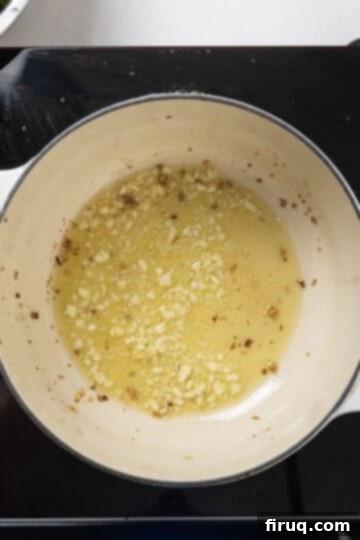
Step 1: Prepare the Rapini and Infuse the Oil. Begin by thoroughly washing your rapini under cold running water. Next, carefully chop off the tough, woody ends of the stalks, usually about 1-2 inches from the bottom. Rinse the greens thoroughly once more, then drain and strain them very well to remove any excess water. In your chosen Dutch oven or heavy-bottomed pot, add the quality olive oil and place it over medium heat. Once the oil begins to shimmer, add the minced garlic. Stir continuously and sauté for 1-2 minutes, or until the garlic becomes beautifully fragrant and just lightly golden. Be vigilant to ensure it doesn’t burn.
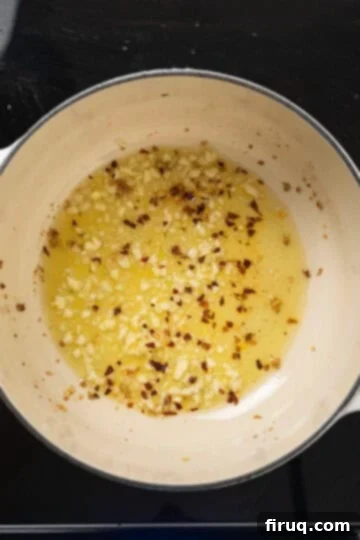
Step 2: Add a Touch of Heat. Immediately after the garlic becomes fragrant and just before it browns, add the crushed red pepper to the pot. Sauté for an additional 30 seconds to a minute, stirring constantly. This brief period allows the gentle heat from the olive oil to lightly toast the pepper flakes, which helps to release their vibrant flavor and create a subtle, warming kick that will permeate the entire dish. Again, remain watchful to prevent any burning.
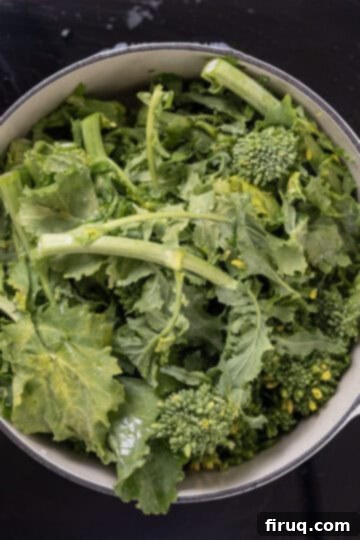
Step 3: Sauté and Steam for Tenderness. Carefully add the prepared rapini to the pot. It will initially look like a significant amount, but don’t worry, it will quickly wilt down as it cooks. Stir everything together thoroughly, ensuring that all the rapini is well-coated with the aromatic olive oil, garlic, and red pepper flakes. Pour in the specified amount of water, then immediately cover the pot with a tight-fitting lid. Allow the rapini to steam and sauté for 5 minutes. This dual cooking action helps to tenderize the greens, softening their stalks and leaves while infusing them with flavor and maintaining their vibrant green color.
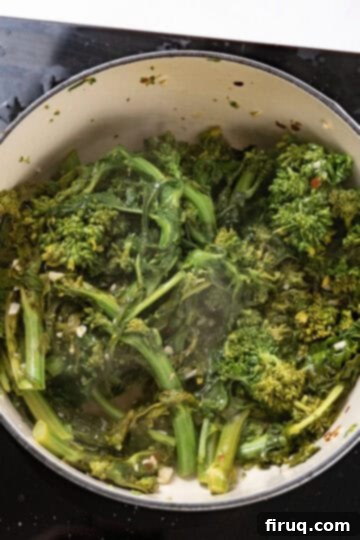
Step 4: Finish and Serve. After the 5-minute steaming period, remove the cover from the pot. Give the rapini another good stir, ensuring all the greens are thoroughly coated and mixed with the flavorful sauce that has formed. Continue to sauté for an additional 2-3 minutes, or until the rapini has softened significantly but the stalks still retain a slight, pleasant crispness. This tender-crisp texture is key to perfectly cooked rapini, ensuring it’s cooked through but not mushy. Just before serving, squeeze in the fresh lemon juice – this essential step brightens the entire dish and beautifully balances the rapini’s natural bitterness. Remove the sautéed rapini from the heat and serve immediately to enjoy this delightful Italian classic!
Pro-Tips for Perfectly Sauteed Broccoli Rabe (Rapini)
To ensure your sautéed rapini with garlic turns out perfectly every single time, achieving that ideal balance of flavor and texture, keep these expert tips in mind:
- Timing is Everything with Lemon Juice: While fresh lemon juice adds a crucial burst of brightness and helps to perfectly balance the inherent bitterness of rapini, it’s vital to add it right at the very end of the cooking process. Do not let the sautéed rapini sit in the lemon juice in the hot pot for too long after it’s finished cooking, as the acidity combined with residual heat can cause the delicate green leaves to turn an unappetizing brown color. For the freshest, most vibrant appearance and taste, squeeze the lemon and serve immediately.
- Garlic Care is Key: Garlic can burn incredibly quickly, and burnt garlic will impart a harsh, intensely bitter, and unpleasant flavor to your entire dish, making it inedible. Always sauté your minced garlic on a controlled medium-low to medium heat. Keep a close eye on it and stir frequently to ensure it just becomes fragrant and lightly golden. Furthermore, when you add the broccoli rabe and water, make sure to stir everything together exceptionally well. If any garlic is left sitting at the bottom of the pan, directly exposed to the heat, it is much more prone to burning even after the rapini has been added. Thorough mixing ensures the garlic is evenly distributed and cooks gently with the greens.
- Don’t Overcrowd the Pan: For optimal results, it’s essential not to overcrowd your cooking vessel. If you are preparing a large batch of rapini that doesn’t fit comfortably in a single layer in your Dutch oven or pot, it’s best to cook it in two smaller batches. Overcrowding the pan significantly lowers the temperature, causing the rapini to steam rather than properly sauté, which can lead to a less desirable, often mushy, texture instead of the desired tender-crisp.
- Season to Taste Throughout: While the recipe provides a guideline for the amount of salt, always taste and adjust the seasoning before serving. Rapini’s unique bitterness can sometimes require a bit more salt or an extra squeeze of lemon to truly make its flavors sing and achieve perfect balance. Don’t be afraid to adjust based on your personal preference.
- Proper Rapini Selection and Trimming: As highlighted in the ingredient notes, selecting fresh, vibrant rapini is paramount for a delicious outcome. Equally important is the trimming process. Ensure you remove enough of the tough, woody bottom stalks to guarantee that every bite is tender and pleasant. You can always test a small piece after cooking to confirm it has reached the ideal tenderness.
Frequently Asked Questions About Rapini (Broccoli Rabe)
This is a common point of confusion for many! Essentially, broccoli rabe and rapini are two different names for the exact same vegetable. They are completely interchangeable terms used to describe the same distinct bitter green, Brassica rapa subsp. rapa. Broccolini, however, is a distinct vegetable altogether. It’s a natural hybrid resulting from a cross between traditional broccoli and Chinese broccoli. While it does have a long, slender stem that can be somewhat similar in appearance to broccoli rabe, its flavor and texture are quite different. Broccolini is much more tender, with a sweeter and milder taste, and notably lacks the characteristic pungent bitterness of rapini.
Rapini boasts a truly distinctive and assertive flavor profile that sets it apart from other greens. It’s best described as pungent, earthy, and notably bitter, often accompanied by a slight peppery undertone. This bitterness, when cooked correctly, is not harsh or unpleasant; rather, it adds a desirable complexity and depth that makes rapini so cherished in Italian cooking. It’s frequently sautéed with aromatic ingredients like garlic and finished with a bright squeeze of lemon juice, which beautifully tempers and complements its inherent bitterness, transforming it into a savory, complex, and immensely satisfying green.
If you find rapini’s natural bitterness to be too intense for your palate, there are effective methods to reduce it. The most common technique is to blanch the broccoli rabe first. To do this, simply immerse the trimmed rapini in a pot of boiling, well-salted water for 1-2 minutes. After blanching, immediately plunge it into an ice bath to stop the cooking process and preserve its vibrant color, then drain it thoroughly before proceeding with the sautéing steps. This blanching process can significantly mellow the bitter notes. However, it’s important to note that blanching can also diminish some of the unique, nutty, and pungent flavors that many people, including myself, cherish about rapini. I personally enjoy its robust, slightly bitter character, as it’s truly meant to be a prominent flavor in the dish, especially when expertly balanced with garlic and lemon.
Absolutely! Sautéed rapini is a fantastic make-ahead dish, making it ideal for meal prepping or entertaining. It tastes excellent whether served warm, at room temperature, or even cold straight from the refrigerator. You can cook a batch and simply store it in an airtight container in the refrigerator for up to 3-4 days. The flavors actually tend to meld and deepen even more after a day or two, making it a convenient and delicious option to have on hand for quick meals or healthy additions to your plate.
Rapini is not only delicious but also incredibly nutritious, making it a true superfood. It’s packed with an impressive array of vitamins and minerals. It serves as an excellent source of essential Vitamins A, C, and K, as well as vital nutrients like folate, calcium, and iron. Additionally, rapini is rich in beneficial antioxidants and dietary fiber, both of which are highly advantageous for digestive health and overall well-being. Its low-calorie and high-nutrient profile makes it a wonderful and flavorful addition to any healthy and balanced diet.
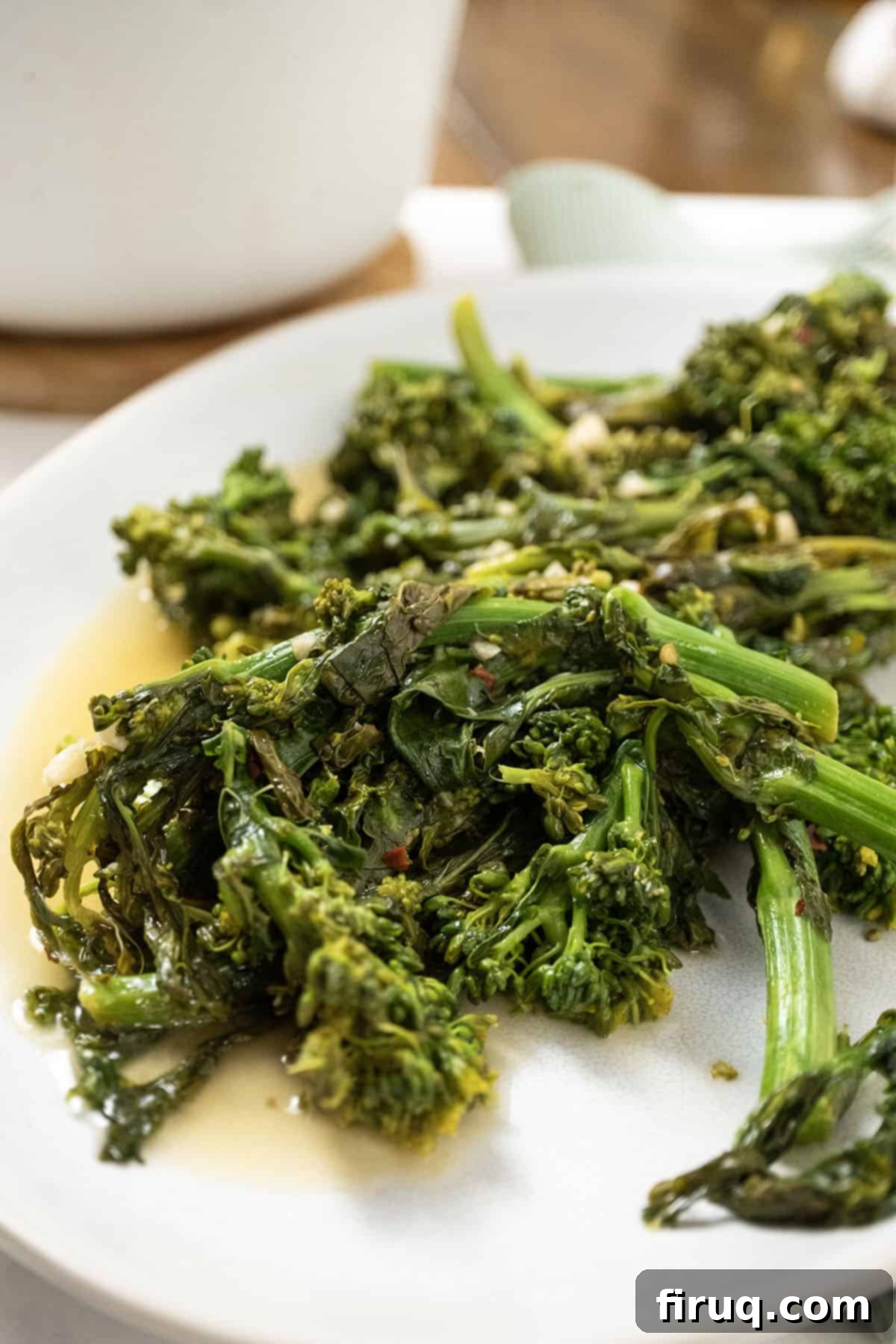
Perfect Pairings: What to Serve with Sauteed Rapini and Garlic
The robust, slightly bitter, and wonderfully garlicky profile of sautéed rapini makes it an incredibly versatile vegetable dish that complements a wide array of Italian classics and extends its appeal far beyond. Its vibrant flavor effortlessly cuts through rich sauces and meats, while also elegantly enhancing lighter, more delicate dishes. Here are some fantastic serving suggestions to inspire your next meal:
- With Chicken Dishes: Sauteed rapini is an exceptional partner to virtually any chicken preparation. Whether it’s the deliciously crispy exterior of a Cast Iron Chicken Breast, the elegant lemony notes of Chicken Francese, or the savory indulgence of Chicken Saltimbocca, the rapini’s earthy tones and slight bitterness beautifully balance the poultry, adding a refreshing depth and freshness to every bite.
- Alongside Your Sunday Feast: For those cherished and hearty Sunday meals where rich, slow-cooked dishes take center stage, sautéed rapini provides a much-needed and welcome green counterpoint. It’s a perfect companion to the deep, slow-cooked goodness of Authentic Bolognese, the tender, flavorful slices of Italian Braciole, or the comforting, generational flavors of Authentic Italian Sunday Sauce. It effectively lightens the meal without compromising an ounce of flavor.
- Complementing Seafood: The bright, pungent, and slightly bitter notes of rapini are surprisingly harmonious and incredibly delicious with various seafood dishes. Serve it as a refreshing, earthy side with the crispy texture of Fried Flounder Oreganata, the delicate flakiness of Pan-Seared Vermillion Snapper, or the unique, satisfying crunch of Pistachio Crusted Fish. It introduces a vibrant green element and a delicious contrast to the often subtle and sweet flavors of fish.
- As a Sandwich Filling or Topping: Don’t limit the versatility of rapini to just a side dish! It makes an incredible, flavorful addition to sandwiches, adding a layer of savory, garlicky goodness and a pleasant texture. Try it piled high on an Eggplant Parm Sandwich, tucked into The Italian Breakfast Sandwich, or as a flavorful, robust component in a Peppers and Eggs Sandwich. Its robust flavor stands up exceptionally well to other strong sandwich ingredients.
- Mixed with Pasta Dishes: While many traditional rapini pasta dishes exist, adding this sautéed version as a side to other pasta preparations is also a fantastic idea. It can be a delightful and healthy accompaniment to a simple Pasta with Cauliflower, beautifully balance the richness of a Creamy Red Pepper Sauce, or offer a fresh, bold contrast to the savory and complex flavors of Classic Linguine Alla Puttanesca.
Watch the Recipe: Sauteed Rapini with Garlic and Lemon
Discover More Authentic Italian Vegetable Dishes
- Easy Steamed Artichokes
- Italian Cabbage Recipe
- Escarole and Bean Soup
- Italian Lacinato Kale Recipe (Tuscan)
Please remember to leave a comment and a star rating below in the recipe card! I truly value hearing your thoughts and experiences with our recipes, as your feedback helps our community of home cooks. Don’t hesitate to tag us on Instagram @vindelgiudice when you share your delicious creations – we love seeing what you make!
📖 Recipe
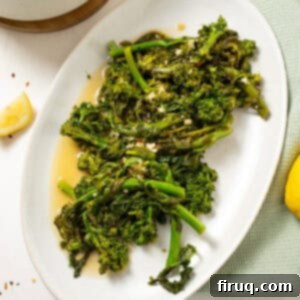
Sauteed Rapini with Garlic
Vincent DelGiudice
Pin Recipe
Equipment
-
1 dutch oven or large pot
Ingredients
- 3 tablespoon olive oil
- 1 head rapini (broccoli rabe)
- 4 cloves garlic, minced
- 1 teaspoon crushed red pepper
- ½ lemon, juiced
- 3 tablespoon water
- 1 teaspoon salt
Instructions
-
Chop off the tough ends of the rapini (approximately 1-2 inches from the bottom). Rinse the rapini thoroughly under cold running water and then strain it very well to remove any excess moisture. In a Dutch oven or a large, heavy-bottomed pot, add the olive oil over medium heat. Add the minced garlic and sauté for 1-2 minutes, stirring frequently, until the garlic is fragrant and just begins to turn a light golden color. Ensure it does not burn.
-
Stir in the crushed red pepper and continue to sauté for another 30 seconds to 1 minute to allow its flavor to bloom. Immediately add the chopped rapini to the pot and stir everything together vigorously to ensure all the greens are well-coated with the garlic-infused oil. Pour in the water and then promptly cover the pot with a tight-fitting lid. Allow the rapini to cook, steaming and sautéing, for 5 minutes.
-
Remove the cover from the pot. Give the rapini another thorough stir, ensuring it’s fully coated in the flavorful sauce that has accumulated. Continue to sauté uncovered for an additional 2-3 minutes, or until the rapini is tender-crisp – softened but still retaining a pleasant, slight bite in the stalks. Just before serving, squeeze in the fresh lemon juice, stir once more to combine, and remove the sautéed rapini from the heat. Serve hot or warm as a delicious side dish.
Notes
- Prevent Browning: It’s crucial to add the fresh lemon juice at the very end of the cooking process and serve the rapini immediately. If the cooked rapini sits too long in the pot after the lemon juice has been added, the acidity combined with residual heat can cause the delicate leaves to turn an unappetizing brown color. Ensure thorough stirring when you first add the rapini to the pot, distributing the garlic and oil evenly.
- Embrace the Bitterness: Rapini is celebrated for its distinctive, pleasant bitterness, which is a key part of its authentic flavor profile. Don’t try to “cook away” the bitterness entirely; instead, appreciate how the garlic, olive oil, and lemon are meant to balance it. Overcooking will not make it less bitter, but rather will lead to a mushy and unappealing texture. Aim for a tender-crisp result that retains some of its characteristic bite.
- Garlic is Delicate: Always keep the heat moderate when sautéing garlic. Burnt garlic will quickly impart a harsh, intensely unpleasant flavor that can ruin your entire dish. Monitor it closely and stir frequently.
- Storage & Reheating: Leftover sautéed rapini can be stored in an airtight container in the refrigerator for up to 3-4 days. It is delicious reheated gently on the stovetop with a splash of olive oil or in the microwave. It also tastes excellent served cold, making it perfect for meal prep or a quick snack.
Nutrition
